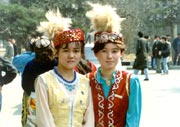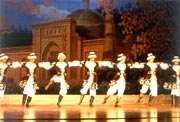|
The nationality that respects swans
 The Hazak nationality is one of the minor nationalities in China. Now her population is more than 1.1 million. They mainly distribute in the Hazak Autonomous Prefecture, and Mulei and Balikun Autonomous counties in Yili, the northern part of Xinjiang. A small part of them distribute in the Mongolian and Tibetan Autonomous Prefecture, Haixi, Qinghai, and the Hazak autonomous county in Akesai, Gansu province. The Hazak nationality is one of the minor nationalities in China. Now her population is more than 1.1 million. They mainly distribute in the Hazak Autonomous Prefecture, and Mulei and Balikun Autonomous counties in Yili, the northern part of Xinjiang. A small part of them distribute in the Mongolian and Tibetan Autonomous Prefecture, Haixi, Qinghai, and the Hazak autonomous county in Akesai, Gansu province.
 The Hazak nationality has a long history. As a single national community, they formed by the long-term contact and harmonization of the descendants of Wusun people and Tujue people in ancient times, part of Qidan people's descendants that migrated to the west in the 12th century and some tribes of Mongolian that rose in the 13th century, and part of nomadic tribes that spoke Tujue language and separated themselves from the Ozbek Kingdom and migrated to the east in the 15th century. "Hazak" means "separators" or "brave and free people". The Hazak nationality has a long history. As a single national community, they formed by the long-term contact and harmonization of the descendants of Wusun people and Tujue people in ancient times, part of Qidan people's descendants that migrated to the west in the 12th century and some tribes of Mongolian that rose in the 13th century, and part of nomadic tribes that spoke Tujue language and separated themselves from the Ozbek Kingdom and migrated to the east in the 15th century. "Hazak" means "separators" or "brave and free people".
The Hazak nationality has its own language and written words. The Hazak language belongs to the Tujue language group, A'ertai language system, and it is based on Arabian letters.
The Hazak nationality's economy mainly depends on animal husbandry, only small numbers of them settle down and are engaged in agricultural production. In the life custom, thick cultural characteristics of animal husbandry are still remained.
The Hazak nationality believes in Islam, Corban and Festival of Fast-breaking are their main festivals. But because of the influence of animal husbandry economy, there are few mosques and scripture schools.
The Hazak nationality is an industrious, brave, warm and hospitable nationality that is proficient in singing and dancing. Their music and dance not only have their own characteristics, but also have a wide mass character. "Dongbula" is their favorite instrument. The Aken playing and singing performance held on the summer pasture every year is the grand meeting of poems and arts of the Hazak people.
<<
The pure white yurt >>
|